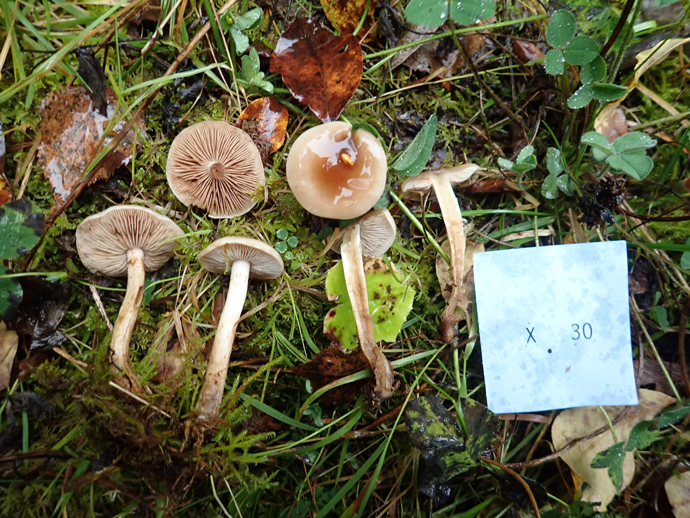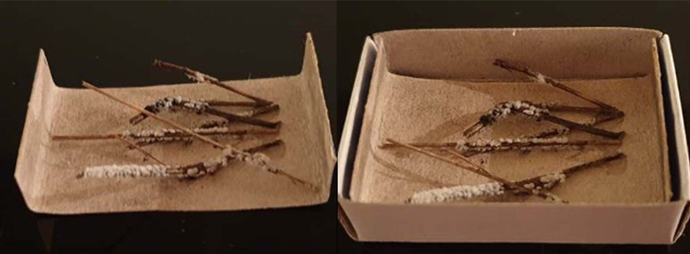We are interested in rare fungi, fungi that occur outside of their known distributional range, and fungal species for which we have few recent collections in public fungaria. There may also be ongoing projects in need of fungal material.
A specimen must be of good quality to be incorporated in the fungarium. The quality includes both the physical object and the associated information. We hope that these guidelines will be of help in cases where your collected fungus should be preserved for posterity.
In the field
Photography
- Take as few and informative pictures as possible. These should preferably include the species in various life stages, displayed at different angles, including upper- and lower surfaces, as well as a through cut (see picture below).
- Take a picture of the collection together with a unique number (see “Fieldnotes”) in order to secure the link between the physical object(s) and the associated field notes.
- Do also take one picture of the surroundings.

Collecting
- Collect only as many fruiting bodies as you will need for determination and specimen deposition. A good specimen consists of healthy fruiting bodies in different developmental stages, among which most should be mature. For small species, you may include ca. 15 fruiting bodies, whereas one would be enough for huge species.
- Make sure the fruiting bodies you collect originate from the same mycelium.
- The collection should be kept separate from other species (e.g. in a paper bag or box).
- Place the piece of paper with the ID number along with the collection.
- REMEMBER: If you plan to collect in a nature reserve, you need to have obtained a collection permit from the County Governor.
- Required collection permits (in print or photographed) must accompany collections delivered to the fungarium.
Fieldnotes
- Give the fungus a temporary name.
- Collection (ID) number – very important for linking the physical object, collection data, and picture(s). Advice: A lottery ticket (e.g. F28) provides, together with the collector’s initials and the date, a unique ID and is convenient to place alongside the object.
- Date.
- Locality and coordinates, and include old municipality name when available.
- Description of habitat (incl. accompanying species of plants and fungi) and the surroundings; the nearest tree species in particular.
- Substrate (e.g. rotting tree trunk, different fungus, moose faeces).
- Many species have discriminating characters that may disappear or change soon after collected. Hence, it is important to observe the fungus while in the field and make notes about smell and color and changes thereof.
- Accompanying collectors (i.e., others who observe the fungus at the collecting site).
- We have made a template for notes that should accompany the specimen. You can download it here.
In the lab
Determination
- Begin the species determination work while the collection is still fresh.
- Make use of literature, online resources, various Facebook-fora, members of local mycological societies etc. as help to reach a reasonable species hypothesis.
- Record what literature you made use of.
- Record whether the collection has been studied under the microscope and, if so, by whom.
- If the collection is being sequenced, please provide information (if available) about where and by whom is was sequenced, as well as who interpreted the sequence and where it can be found.
- If the species you have collected is rare, found outside its known distributional range, or has few or no recent specimens in public fungal collections (information available through Artskart), please deliver the specimen to us for incorporation in the fungarium.
Specimen
- Dry the collection as soon as possible after all needed pictures are taken, the species has been determined (to some level), and all associated notes are made.
- If needed, the collection can be kept in a fridge for up to 48 hours prior to drying.
- Dry the collection at max 35°C on a fungal drier (a slow drying process is better for DNA preservation).
- Adding a kind pressure on the collection while drying will reduce subsequent space needs. Moreover, the collection will become less fragile. Place the objects so as to ensure important determination characters remain visible.
- Large fungi must be divided prior to drying. Make a cross section so that all characters are recognizable.
- In lack of a proper fungal drier, the collection can be dried at room temperature (e.g. in an open paper bag), preferably in a warm place (e.g. on a floor with heating or at the top of a fridge).
- The time needed for drying a collection depends on the type, size, shape, and thickness of the fungus, as well as the temperature, humidity, and drying method. The drying time may range from a few hours to several days.
- Fungi should not be dried in direct sunlight.
- Place the dried collection in a zip-lock plastic bag together with the collection number. Small or fragile fungi should be placed in a glassine bag (if available) or in a clean, small box with acid-free paper for stabilizing.
- Tiny fungi on small pieces of substrate should be glued on acid-free cardboard and placed in a small box (see picture below).
- If you feel unsure the collection is completely dry, you may place a few grains of silica-gel alongside the fungus.
- Dried fungi are susceptible to insect attach. At NHM, we therefore freeze incoming material at -25°C for at least a week prior to bringing the material in to the fungarium.

Specimen to the Natural History Museum
Collections that are already registered in Artsobservasjoner (an online portal provided by the Norwegian Biodiversity Information Centre/Artsdatabanken) will normally reach the fungarium database faster than those that are not.
Collections that are registered in Artsobservasjoner
We are collecting all information and pictures registered in Artsobservasjoner automatically and need only the following delivered together with the specimen:
- a printed label or
- a note with collector, date, locality, species name and AO-number (you will find the AO-number, 8 digits, on the label or at the end of the URL-field).
NB! Only pictures with open source code (Creative Commons BY 4.0) will automatically be copied to our database. If you do not have this source code already, you can change it by going to:
- Your profile - adjust settings - choose source code CC 4.0 BY - save
- Also: source codes - choose same source code - save
Collections registered in separate form
Download and fill out this form if you are sending information about specimens digitally.
Collections that are not registered digitally
- The following information should always follow the collection: locality and coordinates, collection number, collection date, and the collectors name and phone number.
- In addition, as much as possible of the information mentioned above, under the point "Fieldnotes". See also fieldnote template.
- Pictures marked with collection number should be sent to us electronically.
Natural History Museum
University of Oslo
P.O. BOX 1172 Blindern
NO - 0318 Oslo
Fungal collections should only be delivered at (or sent to) the museum upon agreement with the fungarium personnel. Delivered collections become the property and responsibility of the fungarium. Only received material will be registered in the fungarium database. To be incorporated into the fungarium, the specimens need be of good quality. Specimens not fulfilling the quality criteria may be disposed of.